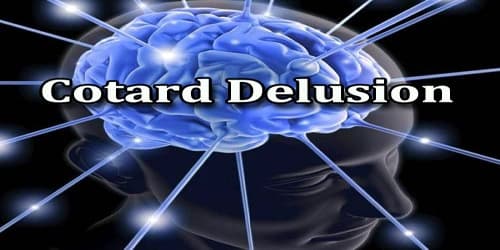Cotard Delusion
Cotard delusion is a rare mental illness in which the affected person holds the delusional belief that they are already dead, do not exist, are putrefying, or have lost their blood or internal organs. It usually occurs with severe depression and some psychotic disorders. It can accompany other mental illnesses and neurological conditions. People might also hear it referred to as walking corpse syndrome, Cotard’s syndrome, or nihilistic delusion. It was named after the French neurologist Jules Cotard who formally identified the illness in 1880. He described it as “The Delirium of Negation” and sufferers typically deny the existence of a body part, a portion of their body or their own existence entirely.
The Cotard delusion is not mentioned in either the Diagnostic and Statistical Manual of Mental Disorders (DSM) or the tenth edition of the International Statistical Classification of Diseases and Related Health Problems (ICD-10) of the World Health Organization.
Signs and Symptoms of Cotard Delusion: The delusion of negation is the central symptom in Cotard’s syndrome. Cotard’s syndrome exists in three stages: (i) Germination stage – the symptoms of psychotic depression and of hypochondria appear; (ii) Blooming stage – the full development of the syndrome and the delusions of negation; and (iii) Chronic stage – continued, severe delusions along with chronic psychiatric depression.
One of the main symptoms of Cotard delusion is nihilism. Nihilism is the belief that nothing has any value or meaning. It can also include the belief that nothing really exists.
Depression is also closely related to Cotard delusion. A 2011 review of existing research about Cotard delusion notes that 89% of documented cases include depression as a symptom.
Other symptoms include:
- anxiety
- hallucinations
- hypochondria
- guilt
- preoccupation with hurting yourself or death
In a study, 100 cases of Cotard delusion were analyzed. It was found that both men and women could get affected by this syndrome. Depression was reported in 89% of subjects. Anxiety was reported in 65% of the cases, whereas guilt was reported in 63% of the cases. Hypochondriacal delusions and delusions of immortality were observed in 58% and 55% of the cases, respectively. Delusions associated with the body were observed in about 86% of the cases, whereas delusions concerning one’s existence were reported in 69% of the cases.
Diagnosis and Treatment of Cotard Delusion: According to the DSM-5 (Diagnostic and Statistical Manual of Mental Disorders, 5th Edition), Cotard delusion falls under the category of somatic delusions, those that involve bodily functions or sensations.
There are no further diagnostic criteria for Cotard syndrome within the DSM-5, and the identification of the syndrome relies heavily on clinical interpretation. It should not be confused with delusional disorders as defined by the DSM-5, which involve a different spectrum of symptoms that are less severe and have a lesser detrimental effect on functioning.
Cotard delusion usually occurs with other conditions, so treatment options can vary widely. However, a 2009 review found that electroconvulsive therapy (ECT) was the most commonly used treatment. It’s also a common treatment for severe depression.
However, ECT does carry some potential risks, including memory loss, confusion, nausea, and muscle aches. This is partly why it’s usually only considered after other trying other treatment options, including:
- antidepressants
- antipsychotics
- mood stabilizers
- psychotherapy
- behavioral therapy
Cotard syndrome resulting from an adverse drug reaction to valacyclovir is attributed to the elevated serum concentration of one of valacyclovir’s metabolites, 9-carboxymethoxymethylguanine (CMMG). Successful treatment warrants cessation of the drug, valacyclovir. Hemodialysis was associated with timely clearance of CMMG and resolution of symptoms.
Information Source:
















